
The Best Hockey Workouts to Build Strength and Stamina
December 15, 2024To build strength and stamina for hockey, focus on a mix of interval training and strength workouts. On-ice, alternate between high-effort skating laps and slower recovery to mimic game conditions. Off-ice, incorporate sprinting combined with lighter jogging and plyometric exercises like box jumps. Strength training with compound movements such as squats and deadlifts will enhance your overall power. Don't forget dynamic warm-ups to increase flexibility and help prevent injury. Proper nutrition and hydration are essential as well. Explore more techniques and strategies to elevate your game and maintain peak performance throughout the season.
Importance of Stamina in Hockey
When it comes to hockey, stamina isn't just a nice-to-have; it's essential for success on the ice. Players engage in short, intense bursts of energy lasting about 45 seconds during each shift, so having high stamina can greatly impact your performance.
With the average player accumulating around 20 minutes of ice time per game, you need to maintain your energy levels throughout to make smart decisions and respond quickly during critical game moments. Cardiovascular endurance is crucial for sustaining energy throughout the game, enhancing your ability to perform at your best. Incorporating high-intensity interval training into your regimen can significantly improve your conditioning for these short bursts of play.
Improved stamina allows you to outlast opponents, reducing fatigue and giving you a competitive edge. When you're conditioned well, you're not just surviving the game; you're thriving in it. This is where strength and conditioning training comes into play, as dynamic warm-up routines can help prepare your body for the demands of the game.
Incorporating specific conditioning training into your routine can greatly enhance your overall performance, ensuring you can push hard from the first to the last minute.
Interval Training Overview
Interval training is a powerful method that enhances your hockey performance by mimicking the sport's intense stop-and-go dynamics. This approach consists of alternating between high-intensity bursts of activity and recovery periods, making it ideal for improving both your aerobic and anaerobic endurance. These endurance levels are critical for maintaining peak performance during intense shifts on the ice.
You can incorporate interval training into your routine with activities like hill sprints and plyometric exercises. These help promote better recovery and adaptation to high-intensity efforts, which is essential for managing the physical demands of a hockey game. Additionally, the inclusion of agility training can further enhance your reaction time and movement on the ice. Moreover, you can also benefit from pain shuttles drill to improve your cardiovascular endurance and anaerobic capacity.
The beauty of interval training is its versatility; you can perform it both on-ice and off-ice, allowing you to enhance your stamina in various training environments. Additionally, interval training is proven to boost cardiovascular and metabolic health, making it a vital component of any athlete's regimen.
On-Ice Interval Training Techniques
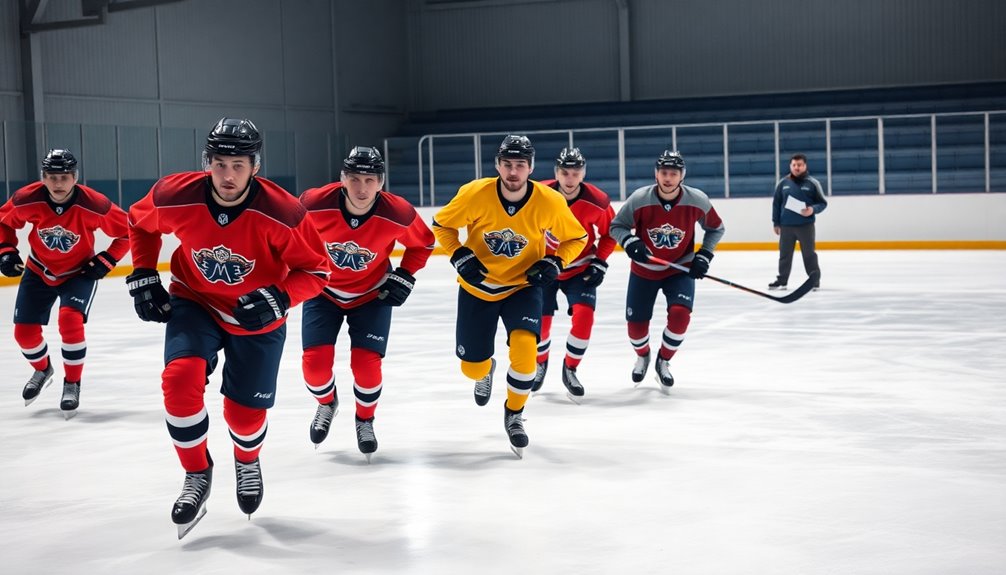
To effectively build stamina on the ice, incorporate interval training techniques that replicate the fast-paced nature of a hockey game. Start by alternating between maximum effort skating laps and slower recovery laps. This on-ice interval training helps simulate the intense bursts of energy required during a game, improving your overall endurance. Anticipation of opponent movements is also crucial in maintaining an edge during these high-pressure moments.
During your high-intensity intervals, add stick handling or shooting drills to enhance your skill application while boosting stamina. For example, sprinting around cones while controlling the puck not only increases your heart rate but also improves agility and puck handling under pressure—key elements in real game scenarios. This approach resembles agility and speed training, which is crucial for enhancing quickness and change of direction on the field.
You can find various on-ice drills online to tailor your training to specific needs and objectives. Incorporate drills that engage your full body to maximize the effectiveness of your sessions. Additionally, a combination of dynamic stretches before and after your workouts can further enhance recovery and reduce injury risks.
By consistently practicing these interval techniques, you'll improve your energy management throughout the game, allowing you to perform at your best during each shift.
Off-Ice Interval Training Methods
Off-ice interval training methods are vital for developing the stamina and strength needed for hockey. By mimicking the sport's stop-and-go nature, these workouts enhance both aerobic and anaerobic endurance. You can incorporate various techniques to elevate your training routine, ensuring it remains effective and engaging.
- Running sprints followed by slow jogging: This combination boosts your high-intensity intervals while allowing for necessary recovery. Engaging in endurance training methods will further enhance your overall fitness levels. Incorporating cardio workouts into your routine can also help improve your speed and endurance.
- Burpees: Integrate these explosive movements into your intervals to maximize energy management and improve overall strength.
- Stationary cycling: Alternate between high and low intensity to build stamina and cardiovascular fitness.
Consistency in applying high-intensity intervals with designated rest periods is essential. It helps you manage your energy better during training while preparing you for the demanding pace of a hockey game. Additionally, incorporating specific drills that enhance reaction time and agility will significantly contribute to your overall performance on the ice.
Circuit training, which includes a mix of exercises performed in succession, keeps you engaged and effectively improves both endurance and strength. By focusing on off-ice interval training, you'll see significant improvements in your game performance, allowing you to skate faster and play harder when it counts.
Year-Round Training Strategies
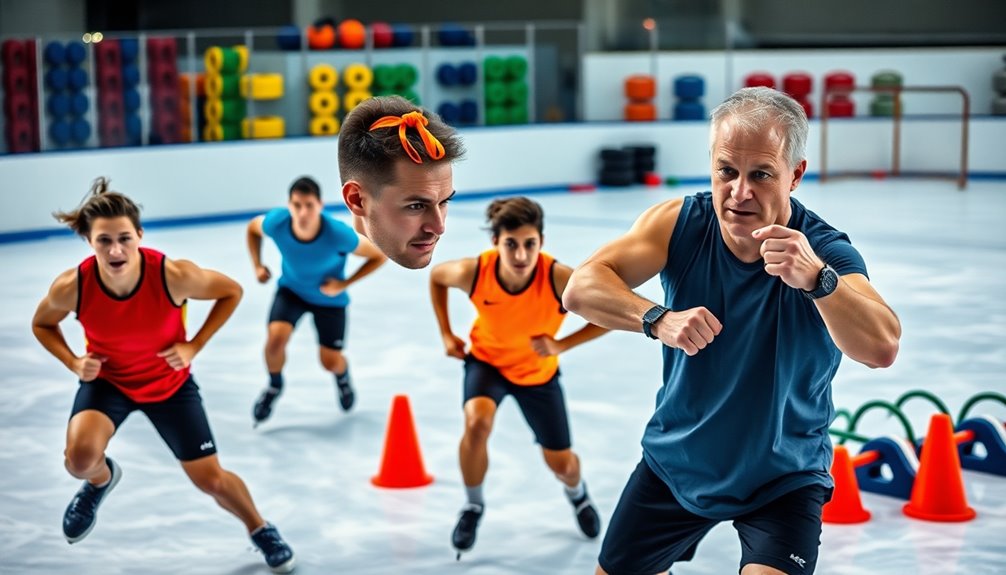
Year-round training strategies are vital for hockey players looking to maintain peak performance and stamina. Implementing a structured training program that includes interval training, both on-ice and off-ice, is essential. This approach mimics the short bursts of energy you'll need during games, helping you maximize performance and endurance. Additionally, consistent effort in training differentiates successful players from others.
During the off-season, when ice time is limited, focus on off-ice training to keep your fitness levels high. Incorporate aerobic conditioning, strength training, and plyometric exercises to enhance overall athletic development. This variety not only boosts your stamina but also aids in injury prevention, keeping you on the ice longer. Additionally, utilizing dynamic warm-up routines before workouts can greatly prepare your body for physical activity and improve overall performance. The evolution of sports like soccer has shown that structured training programs can lead to significant improvements in athletic performance.
Consistency is key. By committing to a year-round training program, you'll experience sustained energy levels during games, allowing you to perform at the best possible level without succumbing to fatigue. Improved strength and stamina give you a competitive edge, enhancing your decision-making during high-intensity situations.
Explosive Speed and Agility Workouts
Explosive speed and agility are vital for hockey players aiming to outmaneuver opponents and make quick plays on the ice. To elevate your game, incorporating targeted speed training and agility workouts can lead to remarkable improvements.
Here are some effective exercises to take into account:
- Box jumps that ignite your explosive power, propelling you off the ice with speed.
- Mountain climber sprints to enhance your starting speed and acceleration, simulating game-like intensity.
- Deceleration suicides that refine your agility, enabling swift directional changes while minimizing injury risks.
The McDavid Explosive Crossover Power Workout focuses on crossover techniques, maximizing your hockey speed with adequate rest between sessions for best performance.
For defensemen, integrating low-effort warm-up runs with box jumps and backpedal sprints is essential for explosive forward motion from a backward position.
If you prefer workouts that can be done anywhere, take into account split squat jumps and squat jumps to target hockey-specific results without equipment.
Conditioning and Endurance Training
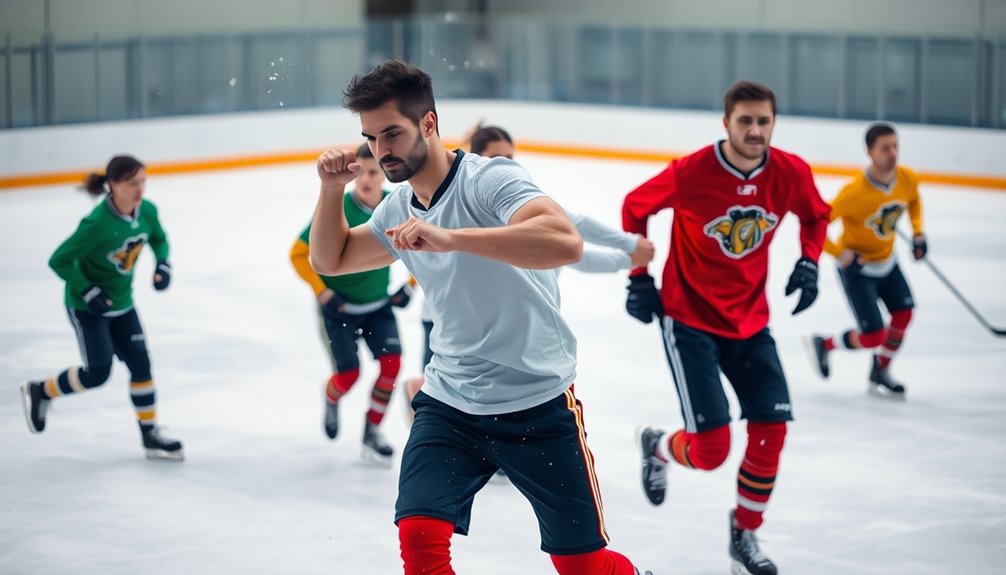
To excel on the ice, you need to focus on conditioning and endurance training.
Incorporating aerobic conditioning techniques, interval training, and plyometric exercises will boost your stamina and power.
These elements are essential for maintaining peak performance throughout intense games.
Aerobic Conditioning Techniques
Aerobic conditioning techniques are essential for hockey players looking to boost their endurance and overall performance on the ice. By enhancing your cardiovascular fitness, you'll be able to maintain a consistent pace during games, helping you stay strong throughout intense physical exertion.
Incorporating activities like running, cycling, and swimming into your routine can elevate your heart rate and benefit your aerobic system.
To maximize your aerobic conditioning, consider these workouts per week:
- Running: Hit the pavement or treadmill, focusing on steady-state runs to build endurance.
- Cycling: Whether outdoors or on a stationary bike, cycling improves stamina while being easy on your joints.
- Swimming: This low-impact activity strengthens your cardiovascular system, providing a full-body workout.
Aim for training sessions at 50-60% intensity to optimize oxygen supply to your muscles.
Regular aerobic conditioning won't only reduce fatigue but also enhance your decision-making and reaction times during play. As you commit to these workouts per week, you'll notice a significant improvement in your ability to keep up with the fast-paced action on the ice.
Interval Training Benefits
Incorporating interval training into your regimen can take your conditioning and endurance to the next level. This method effectively mimics the stop-and-go nature of hockey gameplay, enhancing both your aerobic and anaerobic endurance, which is vital for peak performance on the ice.
By including short bursts of intense activity followed by recovery phases, interval training helps you adapt to high-intensity efforts, making it easier to recover during games. Activities like hill sprints and other explosive movements in your interval training can considerably elevate your overall conditioning.
This not only boosts your stamina but also enables you to maintain sustained energy levels throughout the game, reducing fatigue when it matters most. Regularly implementing interval training during both on-season and off-season prepares you for those intense shifts, where you average around 45 seconds of high effort.
In essence, interval training is a powerful tool that can greatly improve your performance by building the stamina required to keep pushing your limits. So, make it a staple in your workout routine, and watch your endurance soar!
Plyometric Exercises for Endurance
Plyometric exercises are a game-changer for hockey players looking to boost their endurance and explosive power. These dynamic workouts, like jump squats and box jumps, enhance your body's ability to generate speed during high-intensity bursts, which is essential on the ice.
Imagine:
- Bursting off the ice with a powerful jump, leaving your opponents behind.
- Recovering quickly between shifts, ready to dominate the game.
- Maintaining a relentless pace throughout the match, showcasing your stamina.
Incorporating plyometric training into your routine can greatly increase muscle fiber recruitment, improving your explosive movements. These short, intense workouts, lasting 20-30 minutes, mimic the stop-and-go nature of hockey, enhancing both anaerobic and aerobic endurance.
Aim to integrate plyometric conditioning into your training regimen 2-3 times a week, ensuring you allow for adequate recovery periods. This approach not only boosts your performance but also helps you maintain higher energy levels throughout the game.
Strength Training for Hockey Performance
Strength training is a cornerstone of hockey performance, as it builds the power and endurance necessary for success on the ice. Focusing on compound movements like squats, deadlifts, and bench presses, you'll target major muscle groups, enhancing your overall functional strength.
During off-season training, it's vital to incorporate lower body exercises, such as trap bar deadlifts and vertical jumps, to develop speed and prevent injuries.
To maximize your results, adopt a progressive overload approach. Regularly increasing weights or reps guarantees continual adaptation and improvement in your strength.
A well-rounded strength training program should also emphasize posterior chain development through exercises like single-leg Romanian deadlifts and split squats. These movements will improve your skating efficiency and power, essential for dominating on the ice.
Structure your workouts in blocks of 3-4 exercises, allowing for adequate rest between sets. This strategy not only maximizes your athletic performance but also supports recovery during the hockey season.
Plyometric and Explosive Movements
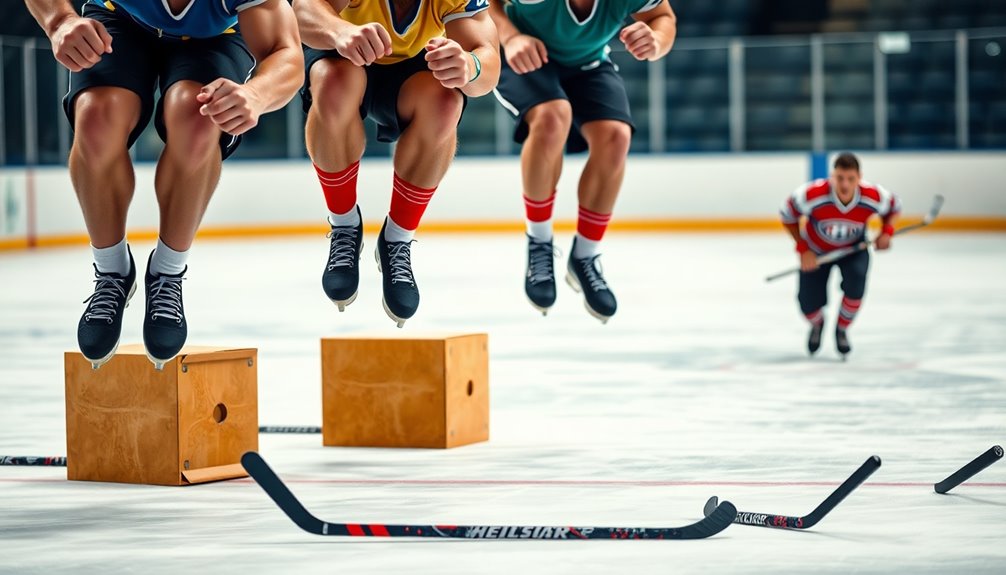
Building on your strength training foundation, adding plyometric and explosive movements can greatly boost your hockey performance. Plyometric training focuses on exercises that engage your fast-twitch muscle fibers, enhancing your power and speed on the ice. Incorporating movements like jump squats and box jumps not only develops strength but also improves your agility, essential for quick changes during games.
Consider these explosive movements to elevate your training:
- Double broad jumps to enhance your distance and acceleration.
- Bounding drills that mimic the skating stride, improving your speed.
- Banded resisted lateral movements to build deceleration mechanics, vital for injury prevention.
Regularly including these agility workouts will translate to significant improvements in your overall athleticism.
However, you need to program these plyometric exercises carefully, allowing adequate recovery time to avoid straining your muscles and joints. Embrace the challenge of plyometric training, and watch how it transforms your on-ice performance, making you quicker and more powerful when it matters most.
Flexibility and Mobility Training
Flexibility and mobility training is crucial for hockey players, as it enhances your range of motion and boosts overall performance on the ice. Effective skating relies heavily on your ability to move freely, and incorporating dynamic stretching routines into your warm-ups can greatly improve flexibility. This enables you to perform at your best throughout games and reduces the risk of injury.
To reveal hip flexibility and improve skating speed, consider a daily hip flow mobility routine that takes less than five minutes. This quick training can have a considerable impact on your performance.
Additionally, total body mobility routines, including exercises like hanging from a pull-up bar and performing rotational arm swings, help enhance your overall mobility, making you more agile on the ice.
Regular flexibility and mobility training supports muscle relaxation and recovery, which are crucial for maintaining your performance and preventing overuse injuries during the demanding hockey season.
Nutrition Strategies for Performance
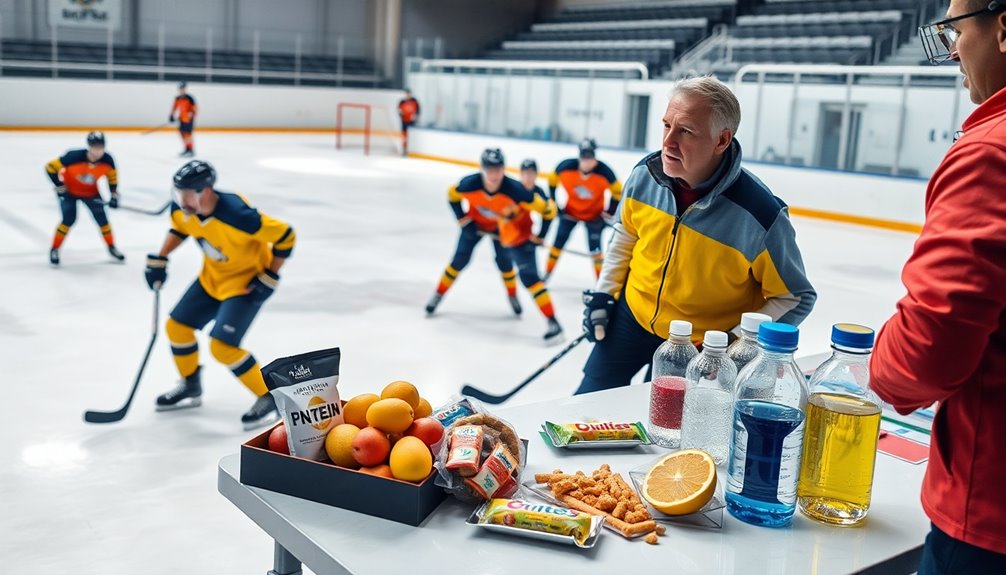
Nutrition plays an essential role in your performance on the ice, and it's important to fuel your body with the right foods. Implementing effective nutrition strategies for performance can make a significant difference in how you feel and play. A balanced diet should include carbohydrates, proteins, and healthy fats to meet your high-energy demands and support muscle repair.
To enhance your performance, consider these staples:
- Lean meats and fish for protein and essential nutrients
- Fruits and vegetables for vitamins and antioxidants
- Starchy carbohydrates like whole grains for sustained energy
Proper hydration is critical, too. Drink water before, during, and after games to prevent even mild dehydration, which can impair your performance and increase fatigue.
Additionally, consuming carbohydrates before hitting the ice guarantees your glycogen stores are maximized for energy during gameplay.
After the game, prioritize post-game recovery nutrition. Aim to consume protein-rich foods within 30 minutes to help repair muscle damage and promote recovery.
Workout Planning and Structure
How do you create an effective workout plan that maximizes your performance on the ice? Start with a solid workout structure that balances strength, speed, and conditioning. Aim for three strength sessions, two speed sessions, and one to two conditioning or mobility sessions each week. This balanced approach guarantees you're developing all necessary attributes for hockey.
Each workout should include essential components like Dynamic Warm-Up, Prehab & Mobility, and Strength & Power Blocks. For strength training, using a superset format with 3-4 exercises allows you to maximize intensity while keeping rest periods effective.
Don't forget to incorporate bodyweight movements, as they help enhance your overall athleticism.
Adjust your training frequency based on the season; in-season players usually benefit from 2-3 strength workouts per week to maintain performance without overloading. Focus on holistic training that targets all muscle groups, particularly the posterior chain, instead of isolating specific muscles.
This thorough approach will improve your on-ice performance and guarantee you're prepared for the demands of the game. Remember, consistency and structure in your training for hockey players are key to achieving your performance goals.
Dynamic Warm-Ups and Cool Downs

Before hitting the ice, dynamic warm-ups play an essential role in priming your body and mind for the demands of hockey. These warm-ups engage you physically and psychologically, preparing you for intense workouts and enhancing your overall readiness for performance.
To get the most out of your warm-up, incorporate movements that elevate your heart rate and mobilize your joints. Consider including:
- Leg swings to loosen your hips and engage your legs
- Walking lunges to activate your quads and glutes
- Arm circles to warm up your shoulders and upper body
After your practice or game, don't skip the cool downs. Proper cool downs should focus on stretching and mobility to aid in recovery and prevent injuries.
Incorporating both dynamic warm-ups and cool downs into your training regimen helps you maintain peak performance while promoting recovery and reducing muscle soreness. Research shows that these warm-ups can even improve important performance measures like speed and agility.
Key Metrics for Performance Tracking
Understanding your performance metrics is essential for tracking your progress in strength and stamina. By keeping an eye on important numbers like reps per set, you can assess how well you're improving during each workout for hockey. Documenting your sets and rest periods helps you identify patterns and make informed adjustments to your training routine.
Incorporating timed sprints and agility drills into your performance tracking can shed light on your speed and endurance. Make certain to monitor your heart rate during interval training too; this will help determine your workout intensity and guarantee you're effectively conditioning your cardiovascular system.
Don't forget to record personal bests in weightlifting exercises like squats and deadlifts. These records are invaluable for gauging your strength progress and tweaking your training as needed.
Additionally, keeping a log of your on-ice performance metrics, such as shift duration and energy output, will highlight areas where you can enhance your stamina and overall game performance.
Conclusion
In hockey, building strength and stamina is like crafting a well-tuned instrument; every element must harmonize for peak performance. By embracing interval training, focusing on nutrition, and committing to year-round strategies, you'll transform your game and elevate your skills. Remember, each workout is a step towards mastering your craft. So lace up those skates, stay dedicated, and watch your hard work pay off on the ice, making every moment count in the exhilarating game of hockey.


